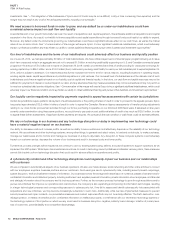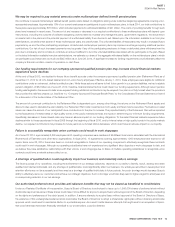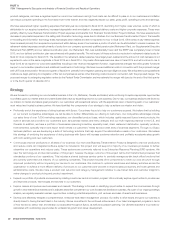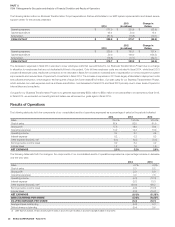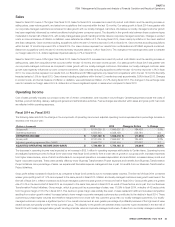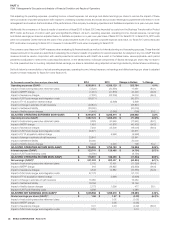Sysco 2014 Annual Report Download - page 33
Download and view the complete annual report
Please find page 33 of the 2014 Sysco annual report below. You can navigate through the pages in the report by either clicking on the pages listed below, or by using the keyword search tool below to find specific information within the annual report.SYSCO CORPORATION-Form10-K 21
PARTII
ITEM7Management’s Discussion and Analysis ofFinancial Condition and Results of Operations
The ve components of our strategy discussed above are designed to drive sustainable pro table growth, increase asset optimization and free cash ow
and increase operating margins. Consistent with these three objectives, in the second quarter of scal 2014, we announced an agreement to merge with
US Foods. US Foods is a leading foodservice distributor in the U.S. that markets and distributes fresh, frozen and dry food and non-food products to more
than 200,000 foodservice customers including independently owned single location restaurants, regional and national chain restaurants, healthcare and
educational institutions, hotels and motels, government and military organizations and retail locations. Following the completion of the proposed merger,
the combined company will continue to be named Sysco and headquartered in Houston, Texas. At closing, Sysco is expected to have annual sales of
approximately $65 billion and with successful integration, we believe at least $600 million in estimated annual synergies can be obtained in the combined
company over a three to four year time period. Expenses to achieve synergies are estimated to be $700 million to $800 million to occur over a three
year time frame once the acquisition has closed. We anticipate some level of capital expenditures primarily for internal use software and other computer
equipment; however, amounts have not been estimated at this time.
As of the time the merger agreement was announced in December 2013, Sysco agreed to pay approximately $3.5 billion for the equity of US Foods,
comprised of $3 billion of Sysco common stock and $500 million of cash. As part of the transaction, Sysco will also assume or re nance US Foods’ net debt,
which was approximately $4.7 billion as of September 28, 2013, bringing the total enterprise value to $8.2 billion at the time of the merger announcement.
As of August 13, 2014, the merger consideration is estimated as follows: approximately $3.7 billion for the equity of US Foods, comprised of $3.2 billion
of Sysco common stock valued using the seven day average through August 13, 2014 and $500 million of cash. US Foods’ net debt to be assumed or
re nanced was approximately $4.8 billion as of June 28, 2014, bringing the total enterprise value to $8.5 billion as of August 13, 2014. The value of Sysco’s
common stock and the amount of US Foods’ net debt will uctuate. As such, the components of the transaction and total enterprise value noted above
will not be nalized until the merger is consummated.
We have secured a fully committed bridge nancing and expect to issue longer-term nancing prior to closing. After completion of the transaction, the
equity holders of US Foods will own approximately 87 million shares, or roughly 13%, of Sysco. A representative from each of US Foods’ two majority
shareholders will join Sysco’s Board of Directors upon closing. This merger is currently pending a regulatory review process by the Federal Trade
Commission. We expect the transaction to close by the end of the third quarter or in the fourth quarter of calendar 2014. Under certain conditions,
including lack of regulatory approval, Sysco would be obligated to pay $300 million to the owners of US Foods if the merger were cancelled, which
would be recognized as an expense.
Business Transformation Project
Our multi-year Business Transformation Project consists of:
•
the design and deployment of an ERP system to implement an integrated software system to support a majority of our business processes and further
streamline our operations;
•initiatives to lower our operating cost structure; and
•initiatives to lower our product cost including a category management initiative to use market data and customer insights to lower product pricing and
enhance our product assortment to drive sales growth.
With respect to our ERP system, we successfully installed a major scheduled update to the system and have deployed the system to twelve locations
as of the end of July 2014. In scal 2015, we will implement a software version upgrade, nalize information technology-related US Foods merger
integration planning and sequencing decisions and enhance the scalability of our shared service center’s processes to prepare for more conversions
in the future. Our goal with integration planning is to sequence the decisions of our ERP implementation to help us achieve the most synergies in
a timely manner.
We are seeking to lower our operating cost structure through various initiatives. These include routing optimization to reduce routes and miles driven, while
improving on-time deliveries. This initiative is expected to be complete by the end of scal 2015. We made substantial progress on our eet and equipment
optimization initiative aimed at reducing costs and optimizing our capital spend. We expect to complete the rationalization of our eet by the end of scal
2015. Driver and warehouse pay structures are being enhanced including tools to more effectively manage labor costs. We are also piloting a program
to increase the amount of recycled material in our operations. We expect to roll out this program across the country by the end of the second quarter of
scal 2015, which should also reduce costs.
We also seek to lower our product costs through various initiatives such as our category management initiative. This initiative is designed to lower our
total product costs and to align our product assortment with customer demand. We are using market data and customer insights to make changes to our
product assortment while building strategic partnerships with our suppliers to grow our sales and our suppliers’ sales. We believe there are opportunities
to more effectively provide the products that our customers want, commit to greater volumes with our suppliers and create mutual bene ts for all parties.
We believe that procuring greater quantities with select vendors will result in reduced prices for our product purchases. In scal 2014, we launched several
product categories, developed and implemented eld-ready sales tools and enhanced customer support and improved communication and coordination
with the eld. By the end of scal year 2015, we expect to have launched all of the categories in the scope of this initiative. We continue to believe this
initiative will provide bene ts to our customers and savings for us over the next few years.



